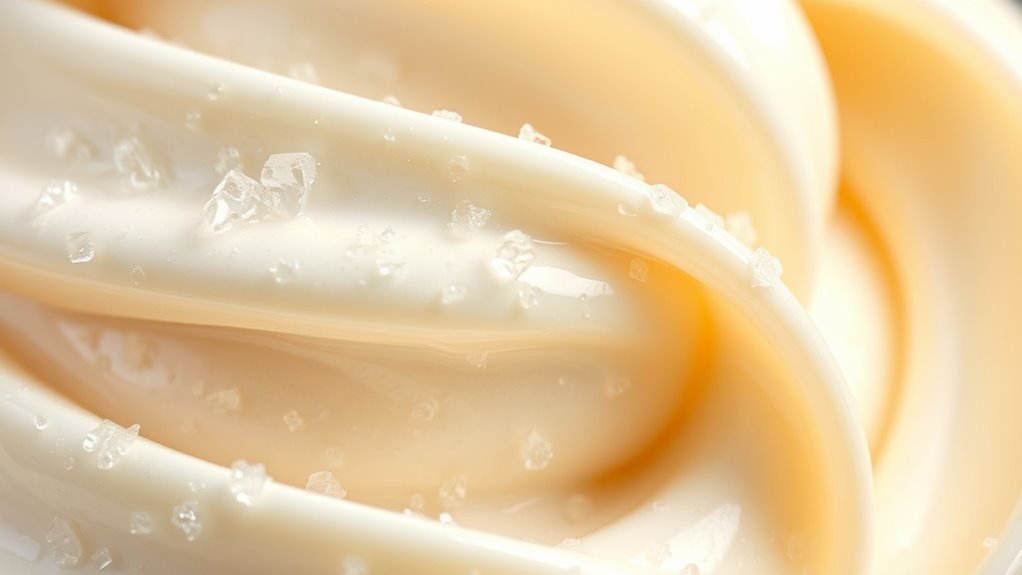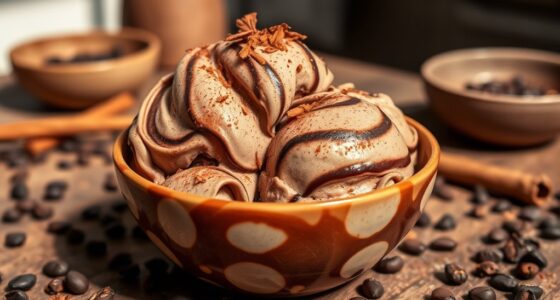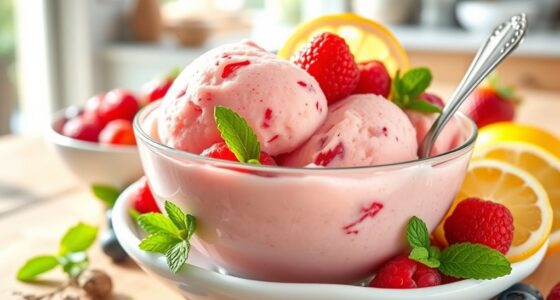Stabilizers and emulsifiers are crucial in ice cream production. They control ice crystal growth, giving your ice cream a smoother, creamier texture. Stabilizers help maintain the structure and extend shelf life, while emulsifiers improve air incorporation and enhance whipping ability. Together, they influence viscosity, prevent ice recrystallization, and create a desirable mouthfeel. Understanding their roles can help you create better ice cream products. Keep going to discover more insights about these essential ingredients!
Key Takeaways
- Stabilizers control ice crystal growth, ensuring a smoother mouthfeel and creamier texture in ice cream products.
- Emulsifiers enhance air incorporation, improving texture and stability against heat shock in low-fat ice cream.
- Both ingredients influence ice crystal size and distribution, resulting in a finer, creamier product with higher viscosity.
- Interactions with sugars and fats improve flavor and sensory experience while also preventing ice recrystallization during storage.
- Selecting high-quality stabilizers and emulsifiers is crucial for achieving consistent texture and desired sensory attributes in ice cream.
Importance of Stabilizers in Ice Cream Production

When you think about ice cream, you mightn’t realize how essential stabilizers are to its production.
Stabilizers and emulsifiers play a vital role in controlling ice crystal growth, which directly impacts the texture of your favorite treat. By preventing the formation of large ice crystals, stabilizers like guar gum and carrageenan guarantee a smoother mouthfeel and enhance creaminess.
Stabilizers like guar gum and carrageenan are key to achieving a smooth, creamy texture in ice cream by controlling ice crystal growth.
They also help maintain the structural integrity of ice cream by stabilizing air bubbles, contributing to its overall body. Plus, using stabilizers can extend shelf life by retarding ice crystal growth and preventing wheying off during melting.
Even though they’re used in small amounts, the right combination can optimize the fat content and improve the final product’s quality and consistency.
Functions of Emulsifiers in Enhancing Texture

Emulsifiers play an essential role in enhancing the texture of ice cream by improving its ability to incorporate air and maintain stability.
By using emulsifiers like polysorbate 80 and monoglycerides, you can greatly increase the whipping ability of low-fat ice cream, leading to greater volume and a smoother mouthfeel.
They also contribute to the stability of your ice cream against heat shock, preventing melting and refreezing that can create undesirable ice crystal sizes.
This reduction in ice crystal size directly enhances the body and texture of the final product.
As a result, consumers find emulsified low-fat ice cream formulations more appealing, ultimately improving their overall sensory experience.
Emulsifiers are key to achieving the desired texture in ice cream.
Impact on Ice Crystal Growth and Viscosity

Stabilizers greatly impact ice crystal growth and viscosity, enhancing the overall quality of ice cream. They influence the size and distribution of ice crystals, leading to smaller crystals that create a smoother texture and creamier mouthfeel.
By slowing down the recrystallization of ice during storage, stabilizers help maintain that fine texture and extend shelf life. When you use a higher viscosity ice cream mix, stabilizers work to produce even finer ice crystals, markedly improving your ice cream’s quality.
Additionally, they form a gel-like network that traps air and moisture, preventing larger ice crystals from forming, which could negatively affect the texture. Overall, stabilizers play an essential role in optimizing both the texture and viscosity of ice cream.
Interactions With Other Ingredients

Interactions between stabilizers and other ingredients in ice cream play an essential role in enhancing texture and flavor. Stabilizers work closely with sugars and fats to improve the overall mouthfeel and flavor release, making your ice cream experience more enjoyable.
When combined with dairy proteins, stabilizers can increase gel formation and alter the freezing point of the mix, which leads to better stability. They also help prevent ice recrystallization during storage, ensuring a fine texture over time.
Additionally, the right stabilizers can influence the flavor profile and sweetness perception, demonstrating their importance in formulation. By carefully selecting stabilizers and emulsifiers, you can maximize the shelf life and consistency of your ice cream, keeping consumers satisfied.
Quality Control and Ingredient Selection

When crafting high-quality ice cream, selecting the right stabilizers and emulsifiers is essential for achieving the desired texture and flavor. The quality of these ingredients directly impacts the stability and sensory experience of your final product.
Variability in stabilizers can lead to inconsistent results, so implementing strict quality control measures is critical throughout production. Proper formulation not only enhances creaminess but also minimizes ice crystal growth, ensuring a smooth texture.
Understanding ingredient interactions, especially between stabilizers and dairy proteins, helps you optimize freezing points and texture. Regular testing and monitoring are important to meet consumer preferences for flavor and maintain a stable shelf life.
Prioritizing quality in your ingredient selection will elevate your ice cream to new heights.
Frequently Asked Questions
What Is the Purpose of Emulsifiers in Ice Cream?
Emulsifiers in ice cream serve to create a smooth, creamy texture by ensuring fat and air are evenly distributed.
They help you whip air into the mix, making your ice cream lighter and fluffier. Additionally, emulsifiers prevent fat separation during storage, keeping the texture consistent.
By reducing ice crystal size, they enhance the mouthfeel, offering you a more enjoyable sensory experience.
What Is Stabilizer Used for in Ice Cream?
Imagine diving into a cloud of creamy goodness that never turns icy!
That’s where stabilizers come into play. They’re your secret weapon, keeping your ice cream silky smooth and free from those pesky ice crystals.
You’ll enjoy a rich, luscious texture that lasts longer, ensuring every scoop feels like heaven. Plus, they help maintain that delightful volume, making every bite a creamy dream, so you can savor every moment without worry!
What Is the Function of Emulsifiers and Stabilisers?
Emulsifiers and stabilizers play essential roles in various food products. They help create a uniform texture by preventing separation and enhancing viscosity.
When you add emulsifiers, you guarantee that fats and liquids mix well, resulting in a smooth consistency.
Stabilizers, on the other hand, reduce ice crystal growth, making the final product creamier.
Together, they improve stability, texture, and overall quality, making your food experience more enjoyable and satisfying.
What Is the Best Stabilizer and Emulsifier for Ice Cream?
You might be wondering which stabilizer and emulsifier will elevate your ice cream to the next level.
Guar gum, paired with locust bean gum, creates a silky texture that keeps ice crystals at bay.
But don’t overlook polysorbate 80! It guarantees your ice cream remains creamy and well-blended.
Striking the right balance between these ingredients can transform your frozen treat into a delightful experience that’ll have everyone coming back for more.
Conclusion
In ice cream, stabilizers and emulsifiers work like a skilled conductor guiding an orchestra, ensuring every ingredient harmonizes perfectly. Just as a conductor balances instruments to create a beautiful symphony, these additives control ice crystal growth and improve texture, delivering a creamy treat that melts in your mouth. So, next time you savor a scoop, remember that it’s not just a dessert—it’s a finely-tuned masterpiece made possible by the unsung heroes of the ice cream world.










